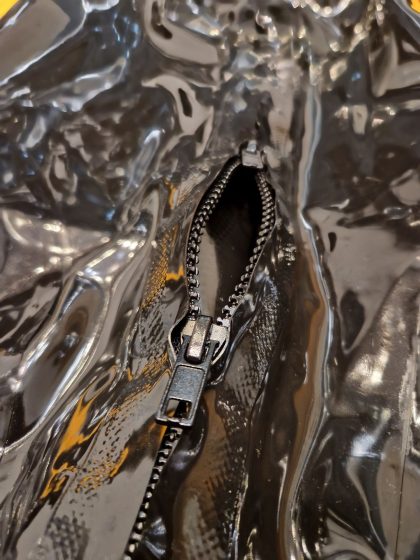Buying
How to buy latex
Buying latex can seem like a rather complicated process. This is especially so in the beginning when we don’t know what to look for. Probably the biggest problem is that most of us can’t just go to a store, touch it, try it on and decide what I like and don’t like. Latex is also a pretty specific material. When choosing clothes, there are several aspects to consider that aren’t even present in “normal” clothes. It gets even more difficult when you order your own clothes designs, and this happens very often. But rest assured – the devil is not as terrible as he is painted. We will look at the most important aspects of latex and clothes made of it. We will tell you what to look for and how to get started.

Thickness
Let’s start with the thickness of the material. This is quite a significant parameter, mainly because of the stretchiness of the rubber. It is assumed that the standard thickness is 0.4 mm. Latex of this thickness is quite stretchy, so it does not excessively restrict movement. Thinner materials are primarily more flexible and therefore less noticeable. However, if they are snagged, it is easier to tear them. An example of such thickness is 0.25 mm. On the other hand, thicker materials are 0.6 mm, 0.8 mm and so on. Clothes made of such material are sometimes referred to as “heavy rubber”. The main difference is that it takes a far greater force to stretch such material than the tension from body movements. This results in a feeling of discomfort. Such latex makes itself known very well when worn. Very often thicker materials are used to make various types of corsets. You should also pay attention to choosing the right size. A thinner latex, even if a little too small, will stretch. Thanks to this it will hug the body very well. If you choose a thicker material, a size which is too small will cause difficulties in dressing and wearing.
At first, try a thickness of about 0.4 mm. If this proves uncomfortable, the next step may be a slightly thinner material. In fact, choosing the right material is a matter of individual taste. Usually, thinner latex works well for underwear, shirts, tops and the like because of its softness.
Dimensions

One of the most important things when choosing latex clothing is choosing the right size. This is due to the fact that most latex garments are tight and are meant to hug the body. This is very often their purpose – to give the effect of a second skin, to emphasize the body. Therefore the clothing must fit well, but it cannot squeeze us too tight. It may be uncomfortable, limit the movements and be dangerous for health. Of course, there are also loose clothes, such as shirts or something like sweatpants. Here, of course, the matter is simpler. Similarly, when buying various latex accessories (such as gloves, socks) the matter is not complicated. The most important thing is that the overall size fits. However, when we want our leggings to highlight our legs perfectly or we want to have a great suit, we need to pay some attention to the right dimensions. First of all, our bodies are very different, so it’s hard to create something universal with the right girths and lengths. When buying, it’s a good idea to go by not standard sizes like S/M/L, but detailed measurements (e.g. calf circumference, hip circumference, armpit circumference, leg length, etc.). If such details are not available, ask the seller. It is much better to explore the subject a little more than to be dissatisfied with your purchase and, worse, to become discouraged with latex.
When choosing new clothes, it’s a good idea to consider the option of having them made to measure (or M2M). This is a particularly good option when buying larger garments, such as catsuits. This may involve more expense (after all, the garment is made specifically for the customer), but the satisfaction can also be much greater.

Colors
When it comes to colors, it is difficult to give an advice. The absolute classic of colors in latex fashion is black. No wonder, because it can be combined with most other colors. The second quite popular color is red, and its combination with black. However, when it comes to colors, the range of possibilities is very large. Colors sometimes vary depending on the manufacturer of the material (not to be confused with the designer, who, like a tailor, creates clothes from ready-made materials). In addition, when creating your own pattern of clothes, nothing limits us. We can combine many colors and in the way that suits us best.
When looking through the colors, there are a few important things to keep in mind. First, in pictures we usually see shiny clothes. Glossy and non-glossy fabric are like two different colors – they have different shades, different depth of color, and different light reflections. So if you get your ordered product, don’t be scared that it’s not your color. The second important thing is transparency. Some colors or materials are specifically made to be transparent or translucent. Some colors, however, are not 100% opaque and become slightly translucent when stretched, for example. So if you want to have a complete coverage, it’s worth making sure about this issue. However, this problem does not occur with most colors, especially the classic ones like black, red, blue, etc. In addition, the thicker the material, the less translucent it will be. Manufacturers of materials often have samples of their colors and thicknesses on offer, so it is possible to stock up on these.
Glued and moulded clothing

Few people realize at first that we can distinguish between these two ways of making clothes – gluing or casting. However, the vast majority of clothes are glued clothes. This is a situation analogous to “normal” sewn clothes. It means that the designer has the material available, from which he makes blanks and glues the whole garment together. This is by far the most popular and best way to create clothes – the designer can do exactly what they want with the material. Generally, the better quality and better fitting the garment, the more elements (panels) and number of gluings it consists of. In some particular cases, the inconvenience of this can sometimes be that very tight clothes leave marks or imprints on the skin through the seams. In places where our body moves a lot (hands, elbows, shoulders), after wearing very tight clothes for a long time, the seam may gently rub against the skin and leave temporary marks. This of course depends on the particular cut, how you wear it, and many other factors. Keep in mind that this is not a big problem and occurs relatively rarely, and such marks always disappear after a few days at most.
The second option for latex clothing is moulded garments, which are garments that are created right away in one piece (or the vast majority). This technique is popular for small garments like gloves, socks and others. However, you can also find larger items such as moulded leggings, pants, T-shirts. The advantage of moulding is the lack of seams and, consequently, full smoothness over the entire surface of the garment and even stretching. It should be remembered, however, that in moulded garments there may be more frequent fluctuations in the thickness of the material. Naturally, the cast is made of liquid latex, so sometimes it is difficult to maintain its even thickness over the entire surface. It is also worth paying attention to whether the material has been damaged or strained in any way during its separation from the mould. Unfortunately, you can also find low-quality clothing among cast-offs, so you need to be vigilant when buying items with suspiciously low prices. Castings are, as mentioned, standard in the creation of gloves, for example. It would be very difficult or even impossible to create glued gloves. Unglued gloves are also obviously more comfortable.

Chlorination
Many people, even those who already own their first latex garments, have not heard of latex chlorination. It is worth mentioning, because some designers or retailers offer latex chlorination as an option. And indeed, chlorination is an additional process that the garment goes through at the very end of its production. In short, chlorination is a chemical process to which latex is subjected. This creates a much smoother surface on the latex. The advantages of chlorination are the partial gloss even without using a glossing aid, the much greater ease of dressing thanks to the smoother surface and the non-stickiness of the clean (without silicone or talcum powder) material. The main disadvantage, however, is the problem with repairing chlorinated clothes. The chlorination process does not cause changes in the deeper structures of the material, however it changes the surface layer. This makes it very difficult or even impossible to repair any tears and damages or generally modify the garment. This is because the glue does not stick to the new surface, the bonding process does not take place properly. Additionally, chlorination changes the smell, it becomes less intense. This can be a pros and cons.
The basic version of latex is always the non-chlorinated version, but the choice of natural latex or additionally chlorinated is an individual matter. For some, chlorination of latex gives it very desirable characteristics, while for others this change will be depriving them of the natural feel of rubber on the skin and its smell.
Zippers

The role of zippers in latex garments is primarily to make them easier to dress and undress. This is especially important for larger garments such as catsuits. The arrangements of the zippers can be very different. The first basic zipper in a catsuit is one long zipper in the front from the neck, through the crotch to the end of the buttocks. This is the kind of zipper we find in “normal” clothes. Its advantage is that it is easy to put the suit on by yourself and to fasten it. The downside for some may be that it is visible when looking at a person from the front. The second very popular arrangement is one long zipper running from the neck through the entire back and step up to the lower abdomen. This option is somewhat the opposite of the first one. Such a zipper is no longer visible from the front, giving the impression of greater smoothness. This version of the zipper has two potential disadvantages. Firstly, it is more difficult to fasten it on the back by yourself, and secondly, the zipper does not stretch – when bending down it can cause a pulling sensation. The mentioned zips are only two basic versions. Others include, for example, a half-back zipper and a crotch zipper, shoulder zippers, etc. Everyone can choose their favorite option. It is worth noting the number of sliders in long zippers. It’s good how there are several, then you can unzip, for example, only the crotch zipper without having to unfasten everything – a very practical option. Also interesting are suits without zippers or with a zipper only in the crotch – these are so-called neck entry suits. They are dressed by stretching the neck and slipping through it.
Zippers are found not only in catsuits, but in many other garments. A common solution is a zipper in the crotch, for example, in leggings. This is a practical option that allows to quickly take care of physiological needs without having to take off the entire garment. Another practical solution is a zipper in blouses and T-shirts – thanks to them, you don’t have to put the clothes over your head.
However, zippers can also have their aesthetic value. Sometimes we do not want to expose the zipper, so it is in the color of the clothes. An interesting option here is the so-called “covered zipper”. On the other hand, however, the zipper can be in a contrasting color to the color of the garment. It is then a thoughtful and purposeful element that adds character to the garment.



Where to start?
Finally, you need to ask yourself one important question – where to start your latex adventure? Or what to gift a loved one to whom you want to show latex? It is often said that it is good to start with something small – this is true! There is no need to invest in a whole catsuit at the beginning, and start with something simpler. This is to get to know the material, how it is worn and its specifics in all aspects. Based on this, you can decide whether you like latex, whether you want something thicker, thinner and so on. If so – you can look for the next clothes. Instead of investing in the big stuff at the beginning, it’s better to spend those funds on latex of slightly better quality and/or made to measure. Then there is definitely a better chance that you will be satisfied with the choice. A good choice for the beginning could be, for example, underwear, shorts, leggings, a skirt or a simple dress.
or in part without the permission of the author.

